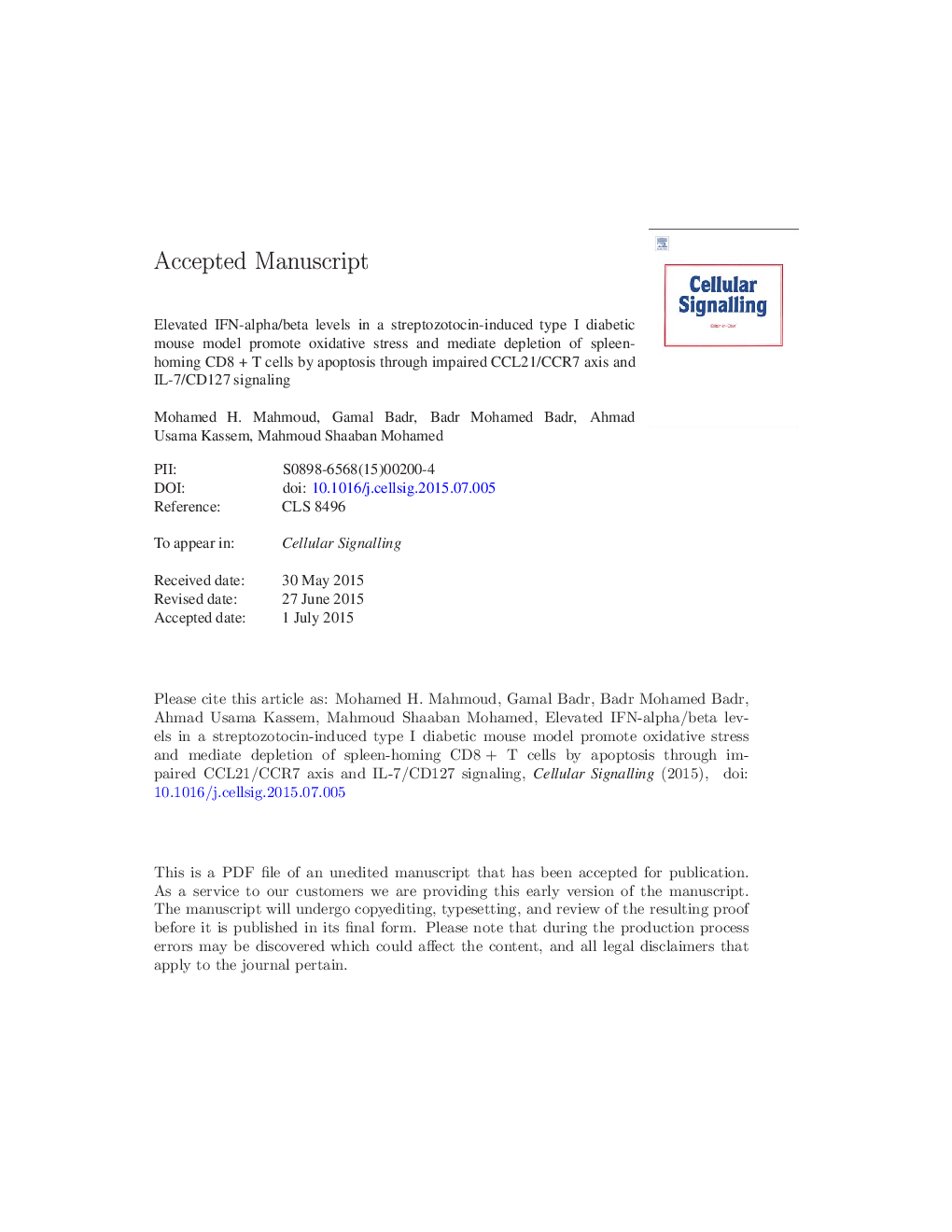| کد مقاله | کد نشریه | سال انتشار | مقاله انگلیسی | نسخه تمام متن |
|---|---|---|---|---|
| 10814836 | 1058411 | 2015 | 44 صفحه PDF | دانلود رایگان |
عنوان انگلیسی مقاله ISI
Elevated IFN-alpha/beta levels in a streptozotocin-induced type I diabetic mouse model promote oxidative stress and mediate depletion of spleen-homing CD8Â + T cells by apoptosis through impaired CCL21/CCR7 axis and IL-7/CD127 signaling
دانلود مقاله + سفارش ترجمه
دانلود مقاله ISI انگلیسی
رایگان برای ایرانیان
کلمات کلیدی
موضوعات مرتبط
علوم زیستی و بیوفناوری
بیوشیمی، ژنتیک و زیست شناسی مولکولی
زیست شیمی
پیش نمایش صفحه اول مقاله

چکیده انگلیسی
Type 1 diabetes mellitus (T1D) is associated with increased type 1 interferon (IFN) levels and subsequent severe defects in lymphocyte function, which increase susceptibility to infections. The blockade of type 1 IFN receptor 1 (IFNAR1) in non-obese diabetic mice has been shown to delay T1D onset and decrease T1D incidence by enhancing spleen CD4 + T cells and restoring B cell function. However, the effect of type 1 IFN blockade during T1D on splenic CD8 + T cells has not previously been studied. Therefore, we investigated, for the first time, the effect of IFNAR1 blockade on the survival and architecture of spleen-homing CD8 + T cells in a streptozotocin-induced T1D mouse model. Three groups of mice were examined: a non-diabetic control group; a diabetic group; and a diabetic group treated with an anti-IFNAR1 blocking antibody. We observed that T1D induction was accompanied by a marked destruction of β cells followed by a marked reduction in insulin levels and increased IFN-α and IFN-β levels in the diabetic group. The diabetic mice also exhibited many abnormal changes including an elevation in blood and spleen free radical (reactive oxygen species and nitric oxide) and pro-inflammatory cytokine (IL-6 and TNF-α) levels, a significant decrease in IL-7 levels, and subsequently, a significant decrease in the numbers of spleen-homing CD8 + T cells. This decrease in spleen-homing CD8 + T cells resulted from a marked reduction in the CCL21-mediated entry of CD8 + T cells into the spleen and from increased apoptosis due to a marked reduction in IL-7-mediated STAT5 and AKT phosphorylation. Interestingly, type 1 IFN signaling blockade in diabetic mice significantly restored the numbers of splenic CD8 + T cells by restoring free radical, pro-inflammatory cytokine and IL-7 levels. These effects subsequently rescued splenic CD8 + T cells from apoptosis through a mechanism that was dependent upon CCL21- and IL-7-mediated signaling. Our data suggest that type 1 IFN is an essential mediator of pathogenesis in T1D and that this role results from the negative effect of IFN signaling on the survival of splenic CD8 + T cells.
ناشر
Database: Elsevier - ScienceDirect (ساینس دایرکت)
Journal: Cellular Signalling - Volume 27, Issue 10, October 2015, Pages 2110-2119
Journal: Cellular Signalling - Volume 27, Issue 10, October 2015, Pages 2110-2119
نویسندگان
Mohamed H. Mahmoud, Gamal Badr, Badr Mohamed Badr, Ahmad Usama Kassem, Mahmoud Shaaban Mohamed,